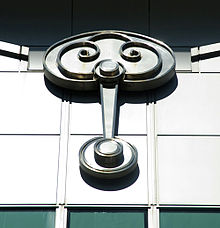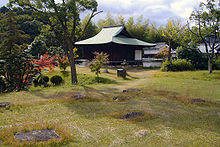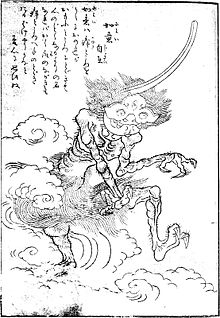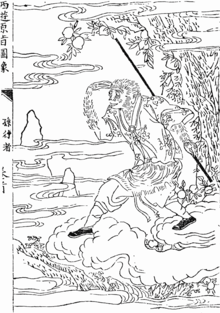- Ruyi (scepter)
-
Ruyi (Chinese: 如意; pinyin: rúyì; Wade–Giles: ju-i; literally "as [one] wishes; as [you] wish") is a curved decorative object that is a ceremonial sceptre in Chinese Buddhism or a talisman symbolizing power and good fortune in Chinese folklore. A traditional ruyi has a long S-shaped handle and a head fashioned like a fist, cloud, or lingzhi mushroom. Ruyi are constructed from diverse materials. For example, the Palace Museum in Beijing has nearly 3000 ruyi that are variously made from valuable materials like gold, silver, iron, bamboo, wood, ivory, coral, rhinoceros horn, lacquer, crystal, jade, and precious gems. The "ruyi" image frequently appears as a motif in Asian art.
Qing Dynasty lacquer ruyi scepter
Contents
Word
The Chinese term ruyi is a compound of ru 如 "as; like; such as; as if; for example; supposing; be like; be similar; accord with" and yi 意 "wish; will; desire; intention; suggestion; thought; idea; meaning; imagination".
Standard Chinese uses ruyi either as a stative verb meaning "as one wishes, as one likes; according to one's wishes; following your heart's desires", or as an adjective meaning "satisfied, pleased, happy, comfortable". The word is combined with suanpan 算盤 "abacus" in the expression ruyi suanpan "wishful thinking; smug calculations".
Chinese ruyi was borrowed as a loanword, yielding the following Sinoxenic pronunciations: Korean language (Hanja 如意, Hangul 여의, Revised Romanization yeo ui, McCune-Reischauer yŏ ŭi), Japanese language (kanji 如意, katakana ニョイ, Hepburn romanization nyoi), and Vietnamese language (Hán tự 如意, Quốc ngữ như ý).
History
Chinese classic texts from the Former Han Dynasty (206 BC - 24 AD) have the earliest usages of the word ruyi. For example, the Shiji history uses it both literally for "as one wishes" and for the given name of Liu Ruyi 劉如意 (d. 195 BC), who was the son of Emperor Gaozu of Han and Concubine Qi.
Scholars have proposed two basic theories for the origin of the ruyi, writes Kieschnick (2003:141). The former is that ruyi originated from Sanskrit anuruddha "a ceremonial scepter" used by Buddhist monks in India, who later brought it to China, transliterated as analu 阿那律 or translated as ruyi. The latter theory is that ruyi originated as a backscratcher in early China, and was amalgamated with the Buddhist symbol of authority.
During the Later Han Dynasty (25-220 AD) and Jin Dynasty (265-420 AD), literati and nobles often held ruyi during conversations and other social occasions. It was called a tanbing 談柄 "conversation baton" (cf. the Native American talking stick) and was used much like zhuwei 麈尾 "fly-whisk", which practitioners of the qingtan 清談 "pure conversation" movement popularized during the Six Dynasties period (220-589 AD).
The ca. 554 AD Weishu history records a story that when Emperor Xiaowen of Northern Wei (r. 471-499 AD) wanted to retire from the throne, he tested his sons by letting them choose among a number objects, and the one who selected a bone ruyi (symbolizing political rule) became Emperor Xuanwu of Northern Wei (r. 500-515). Kieschnick (2003:144) concludes "that by the end of the sixth century, now only was the ruyi common at court, but it had even begun to take on emblematic significance as the mark of a ruler." Although the ruyi symbolized imperial political power, it differed from the Western royal scepter because Chinese officials and monks commonly used it.
The ca. 886 AD Duyang zabian 杜陽雜編, which is a collection of Tang Dynasty (618-907 AD) stories, records that Emperor Wenzong presented an ivory ruyi to the scholar Li Xun (d. 835 AD) and said (tr. Kieschnick 2003:145), "The ruyi may serve you as a lecture baton (tanbing)." Ruyi were both emblems of power and tools of discourse.
In the Ming Dynasty (1368-1644 AD), ruyi became popular as ornaments or gifts symbolizing blessings and good luck. The ca. 1627 AD Zhangwuzhi 長物志 "Treatise on Superfluous Things", by Ming painter Wen Zhenheng, discussed ruyi aesthetics.
The ruyi was used in ancient times to give directions or to protect oneself from the unexpected. It was for this reason that it was made or iron, and not on the basis of strictly aesthetic considerations. If you can obtain an old iron ruyi inlaid with gold and silver that sparkle now and them, and if it has an ancient dull color, this is the best. As for ruyi made of natural branches or from bamboo and so on, these are all worthless. (tr. Kieschnick 2003:151)
During the Qing Dynasty (1644-1912 AD), ruyi scepters became luxuriant symbols of political power that were regularly used in imperial ceremonies, and were highly valued as gifts to and from the Emperor of China. Since 3 and 9 are considered lucky numbers in Chinese culture, Qing craftsmen elaborated the traditional handle and head type ruyi into two-headed sanjiang-ruyi 三鑲如意 "3-inlay ruyi" with precious stones set in both heads and middle of the handle and jiujiu-ruyi 九九如意 "9-9 ruyi" presentational sets of nine. The Qianlong Emperor presented a ruyi to the British ambassador George Macartney in 1793, and in his description (quoted by Kieschnick 2003:139-140), "It is a whitish, agate-looking stone, about a foot and a half long, curiously carved, and highly prized by the Chinese, but to me it does not appear in itself to be of any great value."
 A modern ruyi figure on Taipei 101
A modern ruyi figure on Taipei 101
During the historical evolution of Chinese ruyi "as one wishes", they have been used as backscratchers, ritual objects in Buddhism and later Daoism, pointers for public speakers, prized icons of political power and wealth, and auspicious gifts expressing best wishes.
Art
In art, ruyi scepters often appear as attributes of Buddhist saints and Daoist xian. The god of prosperity Cai Shen 財神 is often depicted holding a ruyi. Stylized repetitions of the shape are incorporated as a motif in the depiction of heavenly clouds. Ruyi symbolize achieving prosperity in fengshui practice. The ruyi shape appears as a motif in decorative knots, Oriental rug patterns, folk artifacts, and even modern corporate logos. Stylized ruyi often function as a kind of ante-fixae or palmette in traditional and modern architecture.
Word usage in East Asian Buddhism
With the introduction of Buddhism in China, scholars used Chinese ruyi 如意 to translate Sanskrit terms, which Japanese Buddhism subsequently borrowed as nyoi 如意. The basic word ruyi (nyoi) "as one wishes" translated three terms.
- kalpavriksha "wish fulfilling tree; the manifestation of what one wishes"
- siddhi or riddhi "spiritual power; supernatural ability to manifest things at will"
- anuruddha "a ceremonial mace; a priest's staff"
The legendary cintamani "wish-fulfilling jewel; jewel that grants all desires" is the most famous Buddhist usage, known as the ruyizhu (nyoi-shu) 如意珠 "as-one-wishes jewel" or ruyibaozhu (nyoi-hōju) 如意寶珠"as-one-wishes precious jewel". The Digital Dictionary of Buddhism's ruyizhu entry explains.
A maṇi-jewel; magical jewel, which manifests whatever one wishes for (Skt. maṇi, cintā-maṇi, cintāmaṇi-ratna). According to one's desires, treasures, clothing and food can be manifested, while sickness and suffering can be removed, water can be purified, etc. It is a metaphor for the teachings and virtues of the Buddha. … Said to be obtained from the dragon-king of the sea, or the head of the great fish, Makara, or the relics of a Buddha.
The ca. 1150 AD Fusō ryakki 扶桑略記 "Brief History of Fusang" by Kōen 皇圓, the teacher of Hōnen, recounts a Japanese nyoi-hōju legend involving the monk Foshi (Bussei) 佛誓 "Buddha's Vow".
There lived in Northern India a Buddhist abbot, "Buddha's vow" by name, who for the sake of mankind sought the "Precious pearl which grants all desires". He went on board a ship and, when in the midst of the sea, by Buddha's power called up the Dragon-king. After having bound him by means of mystic formulae (tantras), he required the pearl from him, whereupon the dragon, unable to escape, took the pearl from his head and prepared to hand it over to the priest. The latter stretched out his left hand, at the same time making the "sword-sign"', a mudrā (mystic finger-twisting), with his right hand. The Dragon-king, however, said: "In former times, when the Dragon-king Sāgara's daughter gave a precious pearl to Cākyamuni, the latter received it with folded hands; why should a pupil of the Buddha accept it with one hand?" Then the priest folded his hands, giving up the mudrā, and was about to take the pearl, when the Dragon-king, no longer suppressed by the mystic sign, freed himself from his bands and ascended to the sky, leaving the abbot behind with empty hands, and destroying his boat. The only man who was saved was the priest himself. Afterwards the same abbot met Bodhidharma, the patriarch, who came across the sea from Southern India (in 526), and together they went to Japan. (tr. de Visser 1913:189)
Erik Zürcher (1997:407) suggests that association between ruyi and the legendary ruyibao "wish-fulfilling gem" explains the dichotomy between it being both a mundane backscratcher and a Buddhist symbol.
Two additional Sino-Japanese Buddhist translations are:
- Ruyiwutan (Nyoi-muton) 如意無貪 "fulfill wishes without craving" translates Analu 阿那律 Anuruddha, one of the original disciples of Gautama Buddha
- Ruyilun (Nyoi-rin) 如意輪 "wish-fulfilling wheel", or Ruyilun-guanyin (Nyoi-rin-kannon) 如意輪観音 translates Chintamanicakra, a manifestation of Guanyin (Kannon) in Esoteric Buddhism, who is usually depicted with the cintamani magic jewel and the falun 法輪 "wheel of dharma" Dharmacakra
 Nyoiji Temple in Kobe
Nyoiji Temple in Kobe
Several Buddhist temples in Japan are named Nyoi.
- Nyoirin-ji 如意輪寺 is a Pure Land temple in Yoshino, Nara, famous for a Nyoi-rin image by En no Gyōja
- Nyoi-ji 如意寺 is a Tendai temple in Kobe, and a Shingon temple in Kyōtango, Kyoto
In some schools of Zen like Sanbo Kyodan, the ceremonial scepter of a roshi is called kotsu 骨 "bone; relic" instead of nyoi.
The scepter has a slight S-shaped curve, like a human spinal column. The rōshi uses the kotsu, for example, to emphasize a point in a teishō, to lean on when sitting, or also occasionally to strike a student. (Diener, Erhard, and Fischer-Schreiber 1991:119)
Other usages in Chinese
In addition to its use in Buddhist terminology, the Chinese word has other meanings. Ruyi can be a proper noun.
- Ruyi 如意 "as-one-wishes" was a 692 AD era name of Empress Wu Zetian
- Ruyiniang 如意娘 "as-one-wishes mother" was the name of a Tang Dynasty Yuefu poem by Wu Zetian
- Ruyi Jingu Bang 如意金箍棒 "as-one-wishes gold banded cudgel" is a magical weapon of Sun Wukong in the ca. 1590 AD Chinese novel Journey to the West
- Ruyiyou 如意油 "as-one-wishes oil" or Yu-Yee oil (from Cantonese) is a therapeutic preparation in Traditional Chinese Medicine
- Ruyicao 如意草 "as-one-wishes plant" is the greater burdock, Arctium lappa
Besides Prince Liu Ruyi (above), Ruyi is used in other personal names.
- Murong Ruyi 慕容如意 was a son of General Murong Baiyao 慕容白曜, both of whom were executed by Emperor Xianwen of Northern Wei in 470 AD
- Pang Ruyi 逄如意 is Gong Li's character in the movie Temptress Moon
Ruyi can also be a place name.
- Ruyiguan 如意館 "as-one-wishes palace" was a Qing Dynasty library in the Forbidden City
- Ruyihu 如意湖 "as-one-wishes lake" is "Lake Ruyi" located near Chengde in Hebei
- Ruyimen 如意門 "as-one-wishes gate" is a historical Siheyuan in Beijing
- Ruyixiang 如意鄉 "as-one-wishes township" is part of Shaoshan city
Other usages in Japanese
 Nyoi-jizai illustration from the Gazu Hyakki Tsurezure Bukuro
Nyoi-jizai illustration from the Gazu Hyakki Tsurezure Bukuro
 Nyoi no Watashi ferry in Toyama
Nyoi no Watashi ferry in Toyama
In modern Japanese usage, the loanword nyoi 如意 "as [one] wishes" means "ease; comfort; freedom" or "(Buddhist) priest's staff".
Besides the Japanese Buddhist temple names above, some other proper names include
- Nyoigatake 如意ケ嶽 "as one wishes peak" is located near Kyoto, and the site of a 1509 AD battle, the Nyoi-gatake no Tatakai 如意ケ嶽の戦い
- Nyoi-jizai 如意自在 "as one wishes, completely free and unconstrained" is the name of a yōkai spirit in Toriyama Sekien's 1781 AD Gazu Hyakki Tsurezure Bukuro
- Nyoi no Watashi 如意の渡し "as one wishes crossing" is a ferry on the Oyabe River in Toyama Prefecture
References
- Diener, Michael S., Franz-Karl Erhard, and Ingrid Fischer-Schreiber. 1991. The Shambhala Dictionary of Buddhism and Zen. Michael H. Kohn, tr. Shambhala.
- Kieschnick, John. 2003. The Impact of Buddhism on Chinese Material Culture. Princeton University Press.
- de Visser, M.W. 1913. The Dragon in China and Japan. Johannes Müller.
- Zürcher, Erik. 1997. The Buddhist Conquest of China: The Spread and Adaptation of Buddhism in Early Medieval China. Brill.
External links
- Ruyi Scepters in the Qing Court Collection, Palace Museum Digital Exhibition
- Ruyi (Ju-i), Glossary of Terms for Antique Chinese Porcelain
- "As You Wish" (Ruyi), The Traditional China: China Culture Index
- Ruyi (Joo-i), The Literature, Culture, and Society of Singapore
- Ru-Yi Knot, Chinese Knotting
Categories:- Buddhist ritual implements
- Chinese art
- Chinese culture
- Mythological objects
Wikimedia Foundation. 2010.




